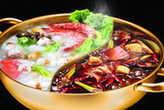TORONTO, Dec. 23 (Xinhua) -- It's been more than a year in the making, but a Canadian design duo are calling the lengthy project they embarked on one of the most challenging and rewarding experiences they've had.
Competing against two other design firms, designers Joe Gault and Avi Dunkelman's stamp designs for the upcoming Chinese Lunar New Year of the snake won the approval of Canada Post, and is set to be released on Jan. 8.
"Working with Canada Post back and forth, and just between Avi and myself, is a very, very long process, but it's one of the coolest projects to work on," Gault told Xinhua recently in the Canadian city of Toronto.
In creating the pair of international and domestic stamps, the duo set out to accentuate the Chinese elements and characteristics of the snake.
Using a number of techniques, including embossing and gold foil stamping, their designs highlight some of the most significant attributes of the Year of the Snake. On the stamp design, the red snake is seen slithering around on a golden background, which is made to look like water, an important attribute in the year of the snake.
"We tried to make it colorful 'cause it's a festivity, it's New Year, a celebration," said Dunkelman. "The symbolism of the gold and the red evoked the feeling of wealth and happiness."
The international stamp shows a yellow and green jade snake wrapped around in the configuration of the number eight, an auspicious number for the Chinese people.
It's one of the very rare projects that allows them to combine so many different techniques in one piece, said Gault.
"You don't do many projects like this," he said. "I'm not too sure, I think it's seven colors, two foils and embossing, I mean, you just don't do projects like that too often, they're not around."
But technicalities aside, one of the biggest challenges for the duo, who had minimal knowledge of the Chinese culture, was to pin down the most important characteristics of the snake.
"The culture of Chinese background is enormously rich," said Dunkelman. "It's colorful, it's full of symbolism, full of tradition. We tried to take all of that and tried to reduce it to one single statement."
It wasn't an easy process. The pair made frequent trips to the Royal Ontario Museum, consulted experts like curators and university professors, did a lot of reading and brainstorming to help give them ideas for their designs, but Gault said the information was limited, and finding original ideas that had never done before proved to be even more difficult.
"We found snakes in relation to three dimensional pottery on teapots and that was actually a possible direction we were going to head in, but pottery had been done before so we had to steer away from approaches that had been previously done," he said.
Both designers exhausted their resources. The two ended up finding help from two unlikely sources: Dunkelman's financial planner and Gault's dentist, who were both of Chinese origin.
"Because it was a very foreign topic for us, we were thirsty for every piece of information we can get," said Dunkelman.
Gault said most of his information was gathered on his dentist's chair.
"It's just very causal conversation while he's cleaning my teeth actually, with my mouth wide open," he said. "But in the end, it became fairly valuable information, and it's always interesting to see where the information comes from and how you absorb it and utilize it into a finished piece."
Having been engulfed with a fountain of information from their research for the last year, both designers said they've not only gotten to experiment with the technical side of the project, but also gained a new appreciation for the Chinese culture.
"I found that very interesting, how Chinese see the snake, how they interpret it, how that then is interpreted into the culture and how they see snake people," said Gault. "I think that was the most interesting part of the research really."
The stamps created by Gault and Dunkelman are the fifth in its series released by Canada Post.





Why not rent a boyfriend, or girlfriend to please parents during the Spring Festival?